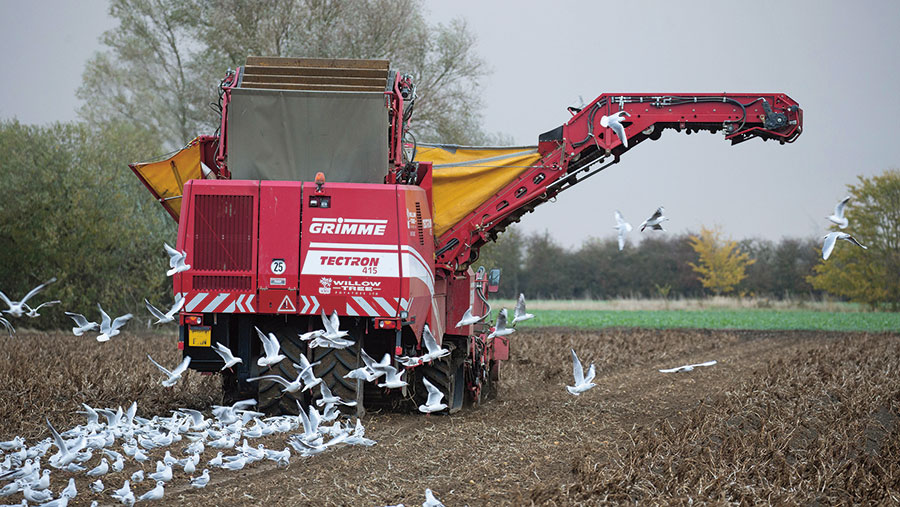Potato crop lowest since 2012
 © Tim Scrivener
© Tim Scrivener At 4.9m tonnes, this year’s potato crop is 13% smaller than the five-year average of 5.6m tonnes, according to an AHDB estimate.
It is only the fourth time since 1960 that the crop has failed to reach the 5m-tonne mark.
The lower crop size is the result of a combination of a 4.4% drop in planted area, to 117,300ha and a 12% drop in average yield to almost 41.7t.
The crop was badly affected by late planting, followed by the prolonged hot and dry weather that stalled tuber growth in June and July.
See also: 10 ways to improve potato storage management
There was huge variation in yield within regions and between fields.
Overall, Scottish crops outperformed those in England, and bucked this year’s lower-yield trend.
At 49.2t/ha crops north of the border were 3% heavier than in 2017 and way above the English yield average of 40.1t/ha, itself a 20% fall compared with the 2017 crop.
However, total Scottish production was down as the planted area fell by 1,600ha to 24,390ha.
Only 53% of the land in Britain planted with potatoes this year had access to irrigation, according to an AHDB estimate.
“Growers were battling a shortage of water this year, as you can see on the AHDB weather hub, the combined June and July period was one of the driest on record,” said AHDB Potatoes sector strategy director Rob Clayton.
“Fields that were irrigated will have enjoyed a reasonable crop, while in others yields were very low.
“We won’t run out of potatoes but what consumers will notice is a wider range of shapes and sizes in the bag they bring home to cook with.
“With fewer potatoes around this year supermarkets won’t be able to only choose from the ‘middle’ section of sizes – hence more variety in the bag.”
Outlook for the rest of the season
AHDB’s recent Horizon Agri-market outlook publication points out there is not only a smaller crop this year but also the prospect of a much shorter season, which could alleviate some supply pressure.
Packers could benefit both from the ability to use old crop longer and through sourcing supplies from Scotland. Almost half of the area grown in Scotland is for packing and yields there are much better than in England.
Chipping and processing markets may face tighter supplies, with their requirement for tubers with certain characteristics suitable for frying. In order to mitigate this, processors have reportedly been looking to source from non-traditional markets, such as packing markets with sufficient dry matter.
This could potentially cause a further tight supply situation in these markets, as competition for supply increases, says AHDB.
Potato consumption trends: Good news on retail sales front
Fresh potato sales grew in the year to the end of May, rising 1.1% by volume sold, which in turn contributed to a 2.2% rise over the past five years, according to analyst Kantar Worldpanel
Fresh potato consumption is expected to remain stable in the short term but the long-term trend of reduced consumption is likely to return at some stage, it warns.
The category faces continued pressures from the rise in dish-based cuisines and growth in rice, noodle and pasta-based dishes.
Sales of crisps and chilled potatoes (such as pre-made mash) grew 6% and 4.2% respectively.
Kantar expects the snack and chilled convenience categories to continue to perform well, driven by new product development focusing on reasons to purchase, such as convenience or exciting flavour combinations.
